When you’ve been bitten by the running bug, even a busy schedule won’t stop you from getting those miles in. Still, you may be tempted to shave time off the beginning and end by skipping a warm-up or cool-down. And while research is mixed on whether stretching exercises prevent soreness or running injuries, post-run stretches are still important for blood flow and heart rate recovery. Plus, they tend to feel pretty darn good.
Here, I’ll give you the best active stretches for your running muscles as you relax for a few minutes post-workout, and let you know how to put them into your own stretching routine.
7 Best Post-Run Stretches
- Wall Calf Stretch
- Half-Kneeling Quad Stretch
- Runner’s Lunge
- Supine Hamstring Stretch
- Supine Inner Thigh Stretch
- Supine IT Band Stretch
- Figure-Four Piriformis Stretch
1. Wall Calf Stretch
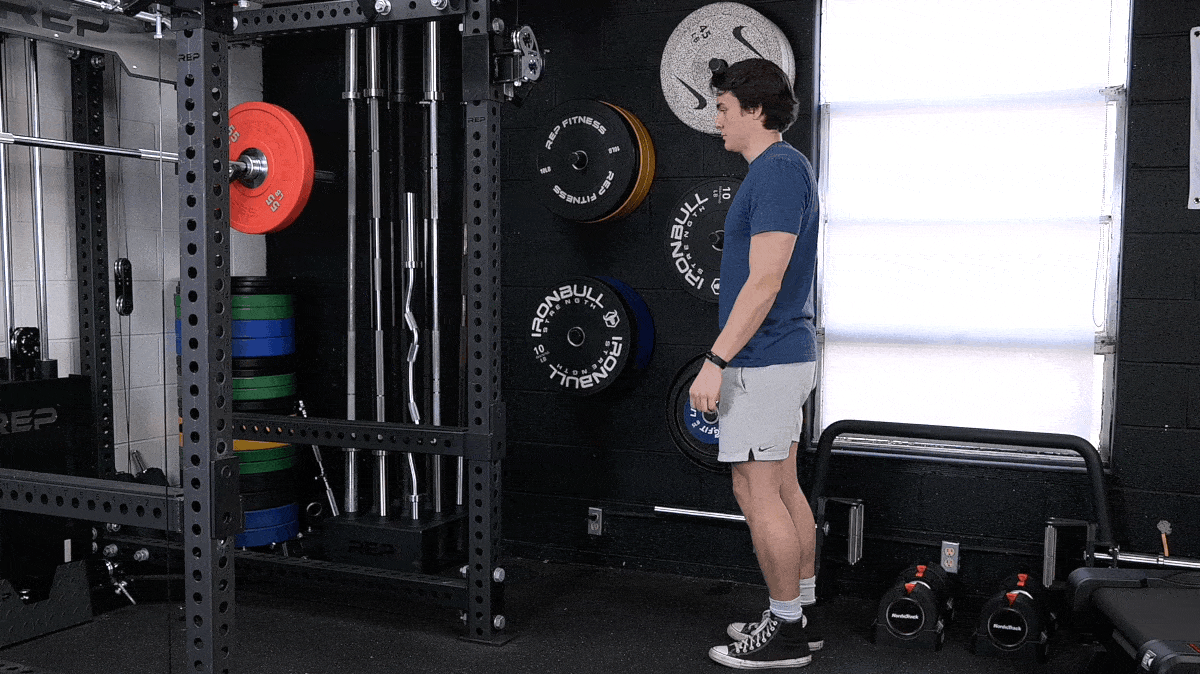
| Equipment Needed | You’ll need a wall or sturdy object to place your hands on. |
| Muscles Worked | Calf muscles (gastrocnemius and soleus) and the bottoms of your feet. |
| Sets & Reps | Perform two sets of 30-second holds. |
[Read More: Try These 8 Stretches to Improve Ankle Mobility]
Your calf muscles do a lot of work on your runs and can quickly tighten up. Taking a few minutes to do the wall calf stretch after a run improves blood flow. Tight calves may restrict ankle mobility and cause foot discomfort; stretching them may ease both.
How to Do It:
- Stand upright with your feet hip-width apart, facing a wall or sturdy object. Place your hands on the wall.
- Step your right foot back behind you. Try to keep the right leg straight and the right heel on the floor.
- Bend your left knee toward the wall and lean forward. You’ll be stretching your right calf. Hold for 30 seconds and breathe deeply.
- Step your right foot forward. Step your left foot back to switch sides and repeat.
Modifications
- Make it Easier:
- Bend your front knee less.
- Bend your back knee.
- Let the heel of your back foot come off the ground.
- Place your back foot on a half-foam roller, plate, or yoga block.
- Make it Harder:
- Perform the downward-facing dog yoga pose for a deeper calf stretch that also stretches your upper body.
- Place your heels on a half-foam roller and perform a forward fold.
- Stand on a sturdy yoga block and perform a forward fold.
2. Half-Kneeling Quad Stretch
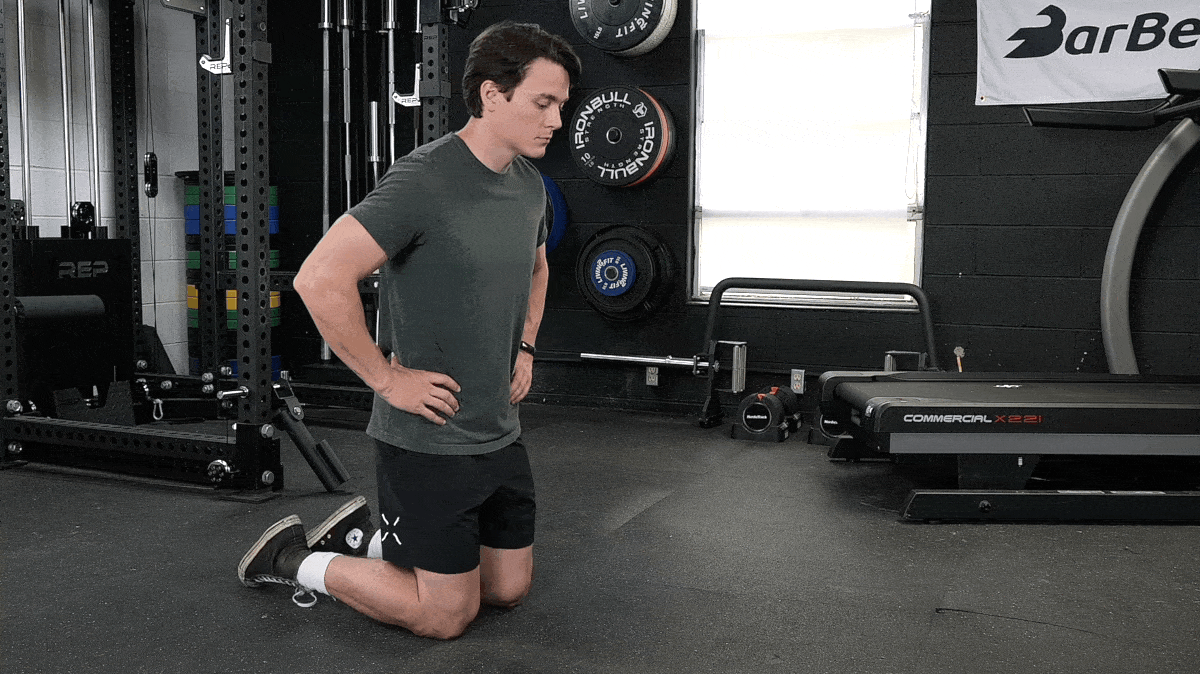
| Equipment Needed | You will need a mat, towel, and possibly padding for your back knee. |
| Muscles Worked | Stretches your quadriceps, hip flexors, and feet. |
| Sets & Reps | Perform two sets of 30-second holds on each side. |
[Read More: The Best 8 Stretches to Do Before a Run, According to a CPT]
Your quadriceps often get overworked on runs, especially if you go uphill. Tight quads can cause hip and knee pain; stretching them out (and foam rolling) may help. The half-kneeling quad stretch doubles as a hip flexor stretch, but you’ll hold the top position instead of leaning forward. Performing it this way also engages your glutes and stretches your feet.
How to Do It:
- Begin in a tall kneeling position with your toes tucked — you may already feel the quad stretch here. Step your left foot forward and keep your right knee down, like the bottom of a lunge position. Keep both knees bent at a 90-degree angle.
- Tuck your hips and squeeze your glutes. You’re stretching your quadriceps on your right leg. Hold for 30 seconds.
- Step your left foot back to a tall kneeling position. Step the right foot forward to switch sides to stretch your left leg. Hold for 30 seconds.
Modifications
- Make it Easier:
- Add a pad under your back knee.
- Untuck your toes on your back foot to stretch the top of the foot and less intensity on the ankle.
- Avoid the Floor: Perform a standing quad stretch.
- If you can’t reach your back foot in a standing quad stretch, place it on a chair behind you.
- Make it Harder:
- Place your back foot on a wall for the more intense “couch stretch.”
- Lift your back foot off the ground and bring it toward your glutes. Try to grab it with your hands.
3. Runner’s Lunge
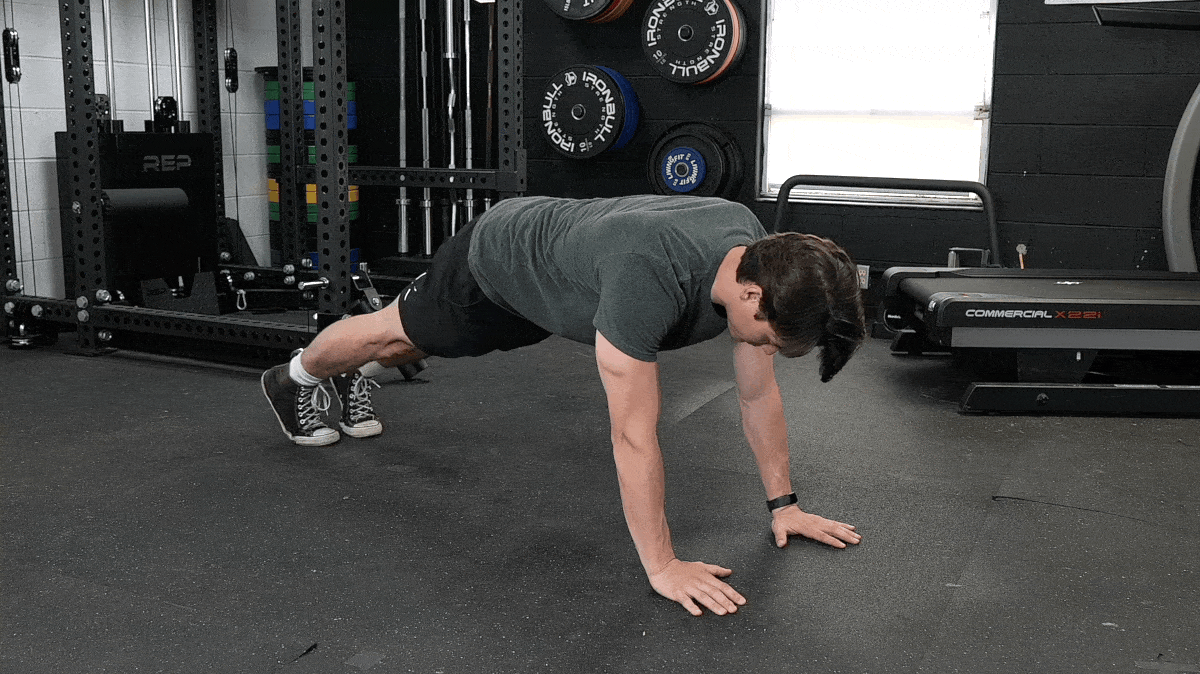
| Equipment Needed | You may want a mat or towel. |
| Muscles Worked | The runner’s lunge stretches your hip flexors, quadriceps, and glutes. With modifications, it also stretches your upper body. |
| Sets & Reps | Perform one 30-second hold on each side. |
[Read More: 5 Minute Mobility: This Stretching Routine Is Perfect When You’re Low on Time]
The runner’s lunge (or low lunge) may feel more like an exercise than a stretch, but it’s not meant as an intense lunge workout. It’s a deeper hip flexor stretch than the half-kneeling quad stretch. Adding a reach or side bend stretches your upper body, as well.
How to Do It:
- Begin in a high plank position. Step your right foot forward and place it next to your right hand. Keep your left leg straight.
- You’re stretching deep in your left quadriceps and hip flexors. Hold for 30 seconds.
- Step your right foot back to the plank position. Step your left foot forward next to your left hand. Keep your right leg straight.
- Hold for 30 seconds, stretching your right side.
Modifications
- Make it Easier:
- Place your hands on sturdy yoga blocks to shorten the range of motion.
- Drop your back knee down to relax your back foot.
- Make it Harder:
- Lower to your forearms for a lizard pose.
- Make it the world’s greatest stretch. If your right foot is forward, keep your left hand on the ground and reach your right arm up, twisting open through your chest. Repeat on the other side.
- Lift both hands off the ground for more leg work. You can also add a side bend here.
4. Supine Hamstring Stretch
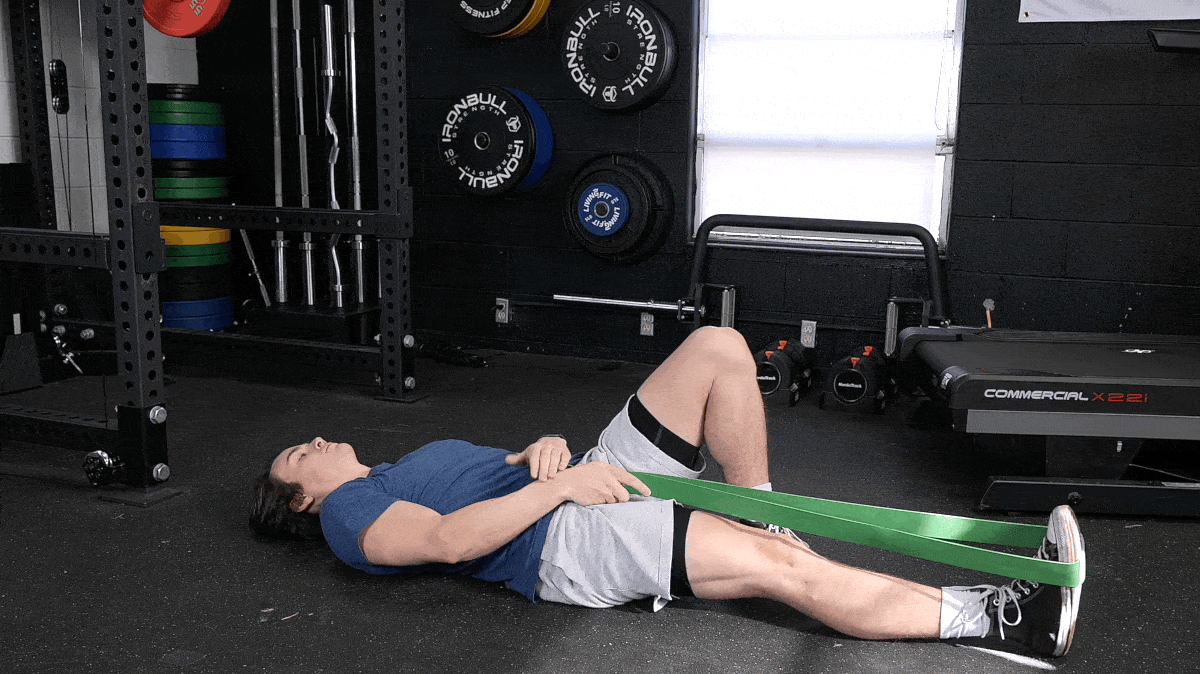
| Equipment Needed | You’ll need a mat and a yoga strap, towel, or long resistance band to assist the stretch. |
| Muscles Worked | Stretches your hamstrings and may relieve some tightness in your lower back. |
| Sets & Reps | Perform two sets of 30-second holds on each side. |
[Read More: The Best Squat Stretch Routine: Great Exercises to Prepare for Squats!]
Although running is a quadriceps-heavy activity, your hamstrings also assist in flexing (bending) your knees and extending your hips. Runners often have tight hamstrings, which can pull on their lower backs, causing pain or discomfort. Doing an assisted static hamstring stretch after a run increases blood flow to the area and may help.
How to Do It:
- Lie on your back. Place your right foot on the floor. Loop a yoga strap, long resistance band, or towel under your left foot. Straighten your left leg. Hold one side of your strap in each hand.
- Inhale, then exhale and lift your left leg. Pull your left thigh toward you as far as you can while keeping the leg straight. Hold for 30 seconds and breathe deeply.
- Lower the left leg down. Loop your strap under your right foot to switch legs and repeat.
Modifications
- Make it Easier:
- Avoid the Floor: Perform a standing forward fold to stretch your hamstrings. Bend your knees if you need to.
- Supine Version: Keep your knee slightly bent.
- Make it Harder:
- To make it an active stretch, skip the assistance, perform an active straight leg raise, and hold at the top for 30 seconds.
- Place your hands on each side of your thigh instead of using a band.
5. Supine Inner Thigh Stretch
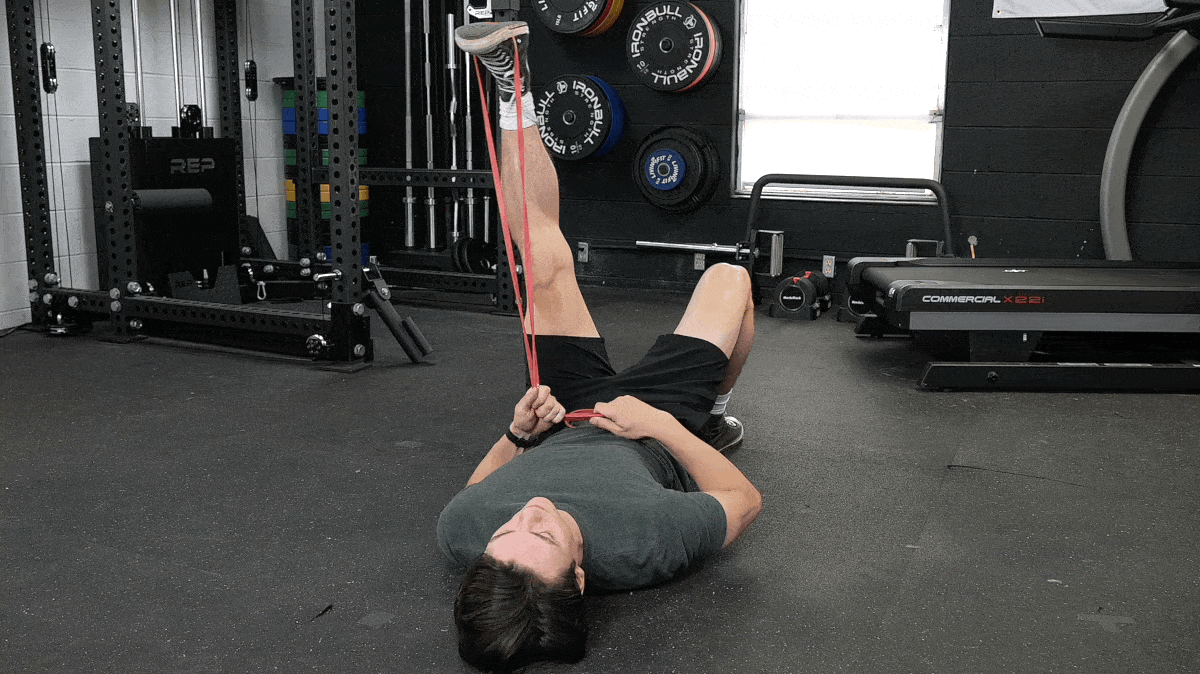
| Equipment Needed | You’ll need a mat and a yoga strap, towel, or long resistance band to assist the stretch. |
| Muscles Worked | Stretches your adductors or inner thigh muscles. |
| Sets & Reps | Perform two 30-second holds on each side. |
[Read More: Mobility Exercises and Stretches to Improve Your Clean and Front Squat]
Your inner thighs (or adductors) are commonly neglected muscles that play a significant role in running performance. Warming them up and strengthening them outside your runs is essential; stretching them afterward helps them relax. This inner thigh stretch is similar to the hamstring stretch, but you hold your leg out to the side.
How to Do It:
- Lie on your back. Place your left foot on the floor. Loop your strap, band, or towel around the sole of your right foot. Lift the leg to your hamstring stretch.
- Place both ends of the strap in your left hand. Lower the right leg out toward the right side while you pull gently with the left hand. Resist letting it fall all the way open. Go far enough to feel the stretch in your inner right thigh. Hold for 30 seconds.
- Return to the starting position. Switch the strap to your left foot and repeat on your left side.
Modifications
- Make it Easier:
- Avoid the Floor: Hold on to a wall and perform a static lateral lunge for 30 seconds on each side.
- Supine Version: Lie next to a wall so the foot of the stretching leg can rest on it, making the stretch more passive.
- Make it Harder:
- Perform without the strap, using your strength to add resistance and hold the stretch.
6. Supine IT Band Stretch
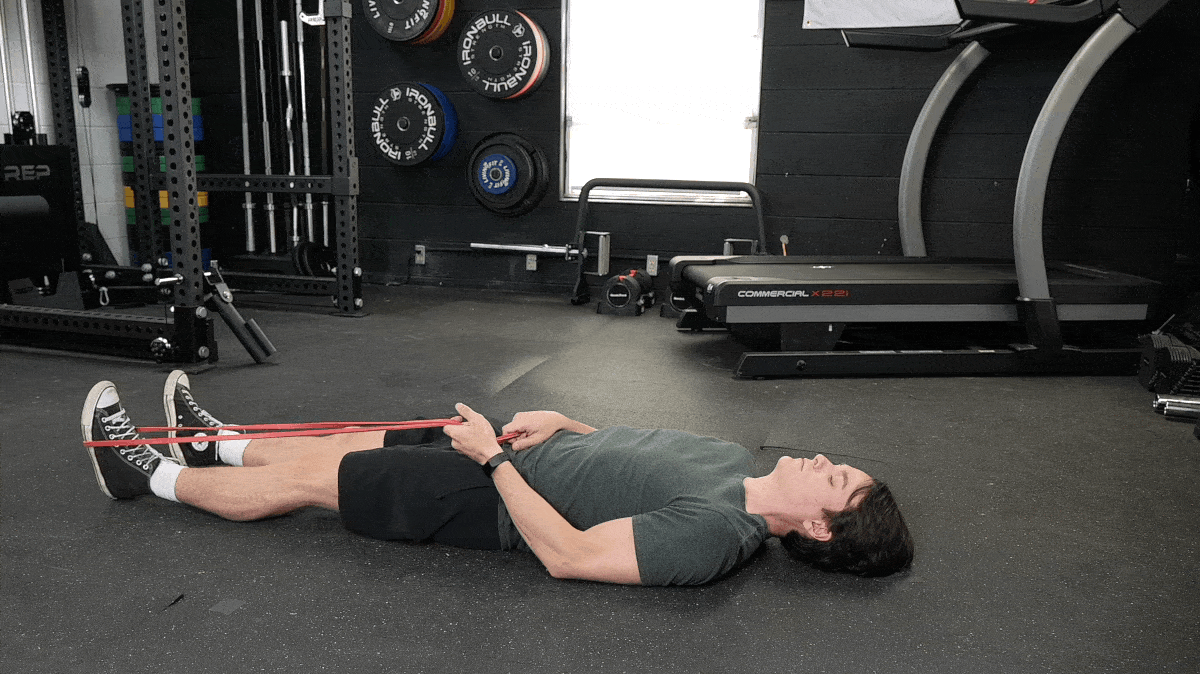
| Equipment Needed | You’ll need a mat and a yoga strap, towel, or long resistance band to assist the stretch. |
| Muscles Worked | Stretches your iliotibial (IT) band, outer hips, and glutes. |
| Sets & Reps | Perform two sets of 30-second holds per side. |
[Read More: Stretches That Can Help Your Posture]
The iliotibial band, known as the IT band, is a common culprit in running injuries. When the IT band gets too tight, it can cause referred hip and knee pain. Stretching and foam rolling can help, but strengthening your glute medius is also necessary. This stretch lengthens the IT band by crossing your leg across your body as you lie down. Getting into it right after your hamstring or inner thigh stretch is simple.
How to Do It:
- Lie on your back. Place your right foot on the floor. Loop your strap, band, or towel around the sole of your left foot. Lift the right leg to your hamstring stretch.
- Place both ends of the strap in your left hand. Keep your bottom foot still. Gently pull the right leg across your body until you feel the IT band stretch in your outer hip. Hold for 30 seconds.
- Return to the starting position. Loop your strap around your right foot to switch sides and repeat.
Modifications
- Make it Easier:
- Avoid the Floor: Perform a standing IT band exercise. Stand with your feet hip-width apart. Cross your left foot in front of your right ankle. Reach your right arm up and stretch your upper body up and over to the right to feel the right IT band stretch.
- Begin with the same foot position, but perform a forward fold with your upper body instead of the side stretch.
- Supine Version: Lie next to a wall so the crossing foot can rest on it.
- Avoid the Floor: Perform a standing IT band exercise. Stand with your feet hip-width apart. Cross your left foot in front of your right ankle. Reach your right arm up and stretch your upper body up and over to the right to feel the right IT band stretch.
- Make it Harder:
- Lose the assistance to make it an active stretch.
7. Figure-Four Piriformis Stretch
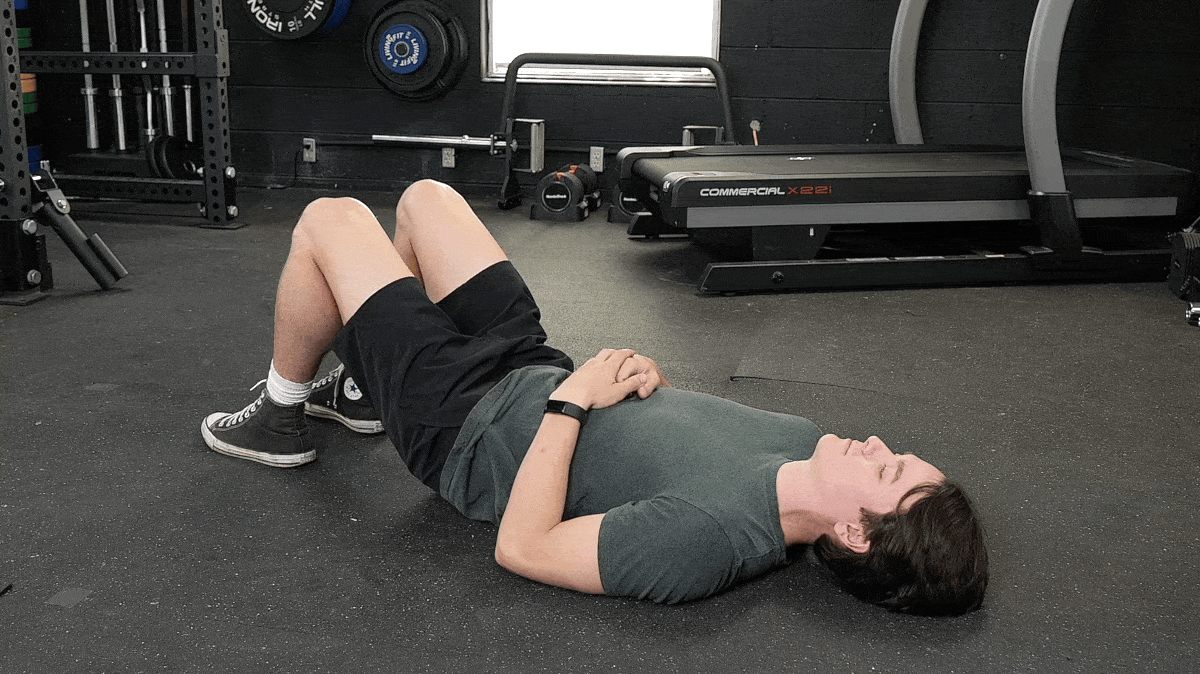
| Equipment Needed | You’ll just need a mat or towel to lie on. |
| Muscles Worked | Stretches your piriformis, hips, and glutes. |
| Sets & Reps | Perform one 30-second hold on each side. |
[Read More: How Deep Stretching Promotes Emotional Release]
The piriformis is a muscle in your glutes that can get tight and cause issues in runners. Your glutes and hamstrings work together to extend your hip. Since your glutes also help stabilize your hips and knees and can contribute to running performance, strong, active glutes help you power forward faster. Weakness often goes with tightness, so be sure to incorporate strength training for your piriformis and glutes outside of your run routine.
How to Do It:
- Lie on your back with your feet flat on the floor, knees pointing up.
- Place your right ankle on your left thigh. Let your right knee open to the side, creating the “figure four” position.
- Place your hands behind your left thigh. Pick up your left foot. Pull your leg toward your body as you continue pushing your right thigh away from you. Resist pushing through your knee. Squeeze your right hip and glute to feel the stretch. Hold for 30 seconds.
- Lower back down to the starting position, switch legs, and repeat on your left side. Hold for 30 seconds. Inhale and exhale deeply.
Modifications
- Make it Easier:
- Avoid the Floor: Sit in a chair (or on a weight bench) with your feet flat on the ground. Place the right ankle on the left thigh, letting the right thigh move toward the floor. Create the same piriformis stretch in this position.
- Supine Version: Stop after the first step. Some people may feel the stretch without lifting their legs off the ground.
- If you can’t reach your thigh with your hands, loop a towel or band behind your thigh to assist.
- Make it Harder:
- Place your hands in front of your shin instead of behind your thigh to deepen the stretch.
- Perform a pigeon pose for a more intense piriformis stretch.
- Perform a standing figure-four pose. Stand on one foot, cross your ankle to your opposite thigh, bend your standing knee, and sit your hips back until you feel the stretch. Repeat on the other side.
Sample Post-Run Stretching Routine
Let’s put it all together. This post-run stretching routine takes you from standing to kneeling to a lunge and finishes with lying on your back. The figure-four stretch often feels intense and may feel more accessible after doing your other leg stretches.
The whole thing should take you 10 to 12 minutes. If you’re in a rush, doing one set of each is still better than nothing and will take less time.
[Read More: The 12 Best Mobility Exercises From a Physical Therapist (+ Tips)]
Equipment Needed: You’ll need a wall or sturdy object to hold on to, an exercise mat or towel to lie on, and a yoga strap or resistance band to assist in stretching. You may also want a chair or bench for some of the modifications.
| Exercise | Sets | Reps |
|---|---|---|
| Wall Calf Stretch | 2 | 30 seconds per side |
| Half-Kneeling Quad Stretch | 2 | 30 seconds per side |
| Runner’s Lunge | 1 | 30 seconds per side |
| Supine Hamstring Stretch | 2 | 30 seconds per side |
| Supine Inner Thigh Stretch | 2 | 30 seconds per side |
| Supine IT Band Stretch | 2 | 30 seconds per side |
| Figure-Four Piriformis Stretch | 1 | 30 seconds per side |
Modifications
- Make it Easier:
- Substitute standing or sitting modifications if you don’t want to or can’t get onto the ground — maybe you want to do it after a run in the park and don’t have a mat. Here’s a quick refresher:
- Replace half-kneeling quad stretch with standing quad stretch.
- Replace supine hamstring stretch with standing forward fold.
- Substitute standing or sitting modifications if you don’t want to or can’t get onto the ground — maybe you want to do it after a run in the park and don’t have a mat. Here’s a quick refresher:
- Replace supine inner thigh stretch with static lateral lunge.
- Replace supine IT band stretch with standing IT band stretch with reach.
- Replace figure-four piriformis stretch with seated figure-four stretch.
- Make it Harder:
- Try the more advanced versions of each stretch:
- Replace wall calf stretch with downward facing dog.
- Replace half-kneeling quad stretch with couch stretch.
- Lower your forearms to the ground in runner’s lunge.
- Perform the supine hamstring, inner thigh, and IT band stretches without assistance.
- Try the figure-four piriformis stretch without assistance or from standing on one leg and sitting your hips back.
- Try the more advanced versions of each stretch:
Benefits of Stretching After Running
Why stretch after running? Here’s what the science says.
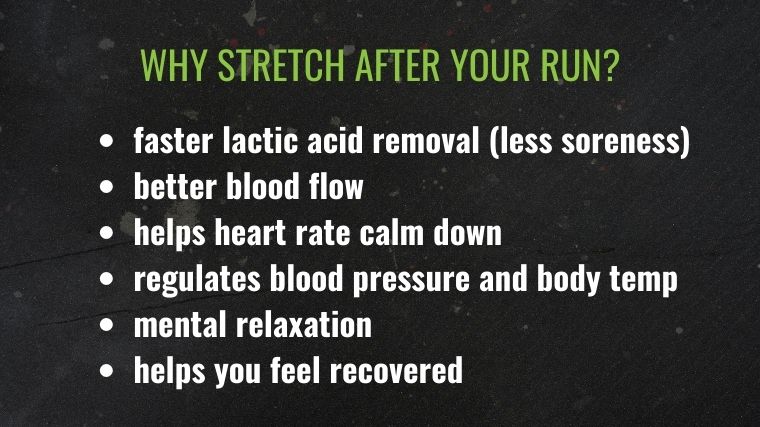
- May speed up lactic acid removal, which could potentially reduce soreness. (1)
- Improves blood flow through the rest of your body to prevent the blood from pooling in your running muscles that you just worked hard. (2)
- Gives your heart rate a chance to return to resting to improve heart rate recovery. (1)
- Allows your blood pressure and body temperature to return to normal, especially if you take a run on a hot day. (3)
- A chance for mental relaxation and to unwind from your tough run.
- Mixed research on whether post-run stretching prevents injuries, reduces soreness, increases range of motion, or improves running performance. (1)
- The placebo effect of post-run stretching makes you feel like you’re improving your recovery. Some studies show this mental effect does boost recovery markers. (4)
Frequently Asked Questions
What stretches should you do after a run?
After a run, you should stretch all your leg muscles by doing the wall calf stretch, half-kneeling quad stretch, runner’s lunge hip flexor stretch, supine hamstring, inner thigh, and IT band stretch, and figure four piriformis stretch.
How soon after running should you stretch?
After your run, take a slow jog or walk for five more minutes to lower your heart rate. You can stretch right after that.
How long should you stretch post-run?
Your post-run stretching routine should take five to 10 minutes, at most 15.
What should you do if you have tight hamstrings?
Never force a hamstring stretch; you can hold it with your knees bent. You can also perform deadlifts to increase hamstring flexibility while you strengthen them.
Editor’s Note: The content on BarBend is meant to be informative in nature, but it should not be taken as medical advice. When starting a new training regimen and/or diet, it is always a good idea to consult with a trusted medical professional. We are not a medical resource. The opinions and articles on this site are not intended for use as diagnosis, prevention, and/or treatment of health problems. They are not substitutes for consulting a qualified medical professional.
References
- Van Hooren B, Peake JM. Do We Need a Cool-Down After Exercise? A Narrative Review of the Psychophysiological Effects and the Effects on Performance, Injuries and the Long-Term Adaptive Response. Sports Med. 2018 Jul;48(7):1575-1595.
- American Heart Association. (2024, January 16). Warm Up, Cool Down. Heart.org.
- Seeley AD, Giersch GEW, Charkoudian N. Post-exercise Body Cooling: Skin Blood Flow, Venous Pooling, and Orthostatic Intolerance. Front Sports Act Living. 2021 May 17;3:658410.
- Cook CJ, Beaven CM. Individual perception of recovery is related to subsequent sprint performance. Br J Sports Med. 2013 Jul;47(11):705-9.